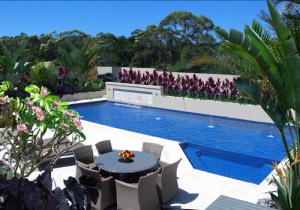Pool renovation to the rescue

Christina DiMartino asked builders and suppliers about renovating swimming pools, and discovered the economic downturn – particularly in the US – has led to an increased popularity for renovation over new builds. This is an abridged version of the article that appeared in the June issue of SPLASH!
Steve Zorn is regional sales manager for California, Pentair Water Pool and Spa. He says pool renovations have always been a part of the company’s core business.

“Many people initially just want to dress up their pools with new equipment so it’s a better match to the look and feel of their home,” he says. “What homeowners have to understand is that its goes beyond the look and feel of the pool and offers numerous opportunities to create a significant cost saving and energy reduction.
“From the equipment side, it’s important to take the numerous new energy efficient pool products into consideration that were not available a few years ago.” he says. “Variable speed pump technology simply didn’t exist. And modern colour changing LED lights save energy and last longer.”
He says that most homeowners opt for a renovation rather than a new build today, and the economic downturn affecting the housing industry during the past few years has a lot to do with their choice. In the US, people are also more apt to invest in upgrading their current homes rather than purchasing a new one, and this has a direct impact on the investments people are making on their pools.
For more than a decade, Les Schiff, president and contractor, USA Pools, Inc., South Florida, has engaged in pool renovations in addition to new pool design and construction.
“Eight out of ten of our jobs are new construction, and the balance are renovations,” he says. “The majority of the basic renovations we do are new finishes, like switching to Diamond Brite, or changing the coping or tile with updated materials,” he says. “Many people are tired of their old decking, and they want a facelift.”

New pumps and filters are more efficient than those of the past, so Schiff says his customers typically want their equipment updated, as well as their overall plumbing. Chlorine generators are also in demand in renovation projects.
Today’s lighting options are so much more dynamic than they were a decade ago, and electronic controls offer more convenience, so Schiff says people typically want to add these features in a renovation.
“The majority of renovation projects include going from white lights to products like Jandy’s lighting shows,” he says. “Waterfalls are also popular today, but they don’t usually involve ripping out a pool. Aesthetics are what most people are looking for today. They want to add accessories that will make the pool look better, like tiki huts and outdoor kitchens.”
Schiff concurs that the past few years have been difficult in the pool industry because of the depressed economy, and it has also affected the renovation part of business.
“Five years ago I had twenty pools going at one time, and we’re now averaging about two,” he said. “Things are starting to turn around just in the past couple of months, however.
“The biggest problem for homeowners is that banks aren’t loaning money. Home appraisals are low so home owners have less equity in their homes and can’t afford to make improvements.”
Shiff says that in the US, a renovation can run in the range of $6000 to $7000, while building new runs to around $40,000. With money tight today, people are more inclined to renovate their existing pool.
But when it’s done right, it’s like getting a brand new pool. When a pool is in good shape—no cracks in the shell for example—a new finish can make it look like a newly built pool. But about one out of ten of USA Pools’ customers want to add a spa to the pool, and that does involve major changes.
“Even if a shell is cracked, there are procedures that can be done like putting staples in it and drilling it back together, and then resurfacing it,” he says. “In my experience, at least 90 percent of pools are in repairable shape and can be renovated. Changing the shape or adding a spa is major, however. Both can be more of a hassle than building new.”
Pool building in Florida means dealing with water tables. If a shell is completely sealed, rising water tables cause pressure to build beneath it causing a condition called hydrostatic uplift. This can cause a pool to pop out of the ground.
“In these cases, homeowners need to deal with someone who really knows about this issue,” he says. “The pool either has to be completely ripped out or the beam line needs cut, and both are major jobs. The best thing to do in this case is to tear out the pool and rebuild from scratch.”
Chris Hitchins, director of Hitchins Technologies in Ashmore, Queensland, has been involved with pool waterproofing and protective coatings in the Australasian region since the 1970s. He says about half of the pools in Australia are more than 15 years old, and many are showing their maturity.
“It’s not a pretty sight, but all is not lost,” he says. “These pools can be bought back to life with some TLC.”
Hitchins Technologies began in business in 2005. The company does not do pool renovations, but it supplies the epoxy coatings for pools. It also offers comprehensive technical information and support.
“It’s important to understand and deal with an existing pool’s history, from the date of design and building, through the many years of use and abuse, to the day that it comes up for renovation,” says Hitchins. “This may include poor design, poor concrete placement and compaction. Some have had little or no pool water management during its lifetime due to the lack of owner knowledge.”
He adds that a high water table, osmosis and incomplete pool plumbing sometimes results in unrealistic outcomes.
“It is not possible to make a silk purse out of a sow’s ear,” he says. “With some thought and care, however, a great result can be had without a huge investment. In some cases pools have had their original owner maintaining them religiously for their entire lives, and now need only a minor refreshing to look updated again. Each pool has its own unique history.”
Hitchins agrees that during economic downturns, pool upgrades are more popular than new pool construction. For 25 per cent to 40 per cent of the cost of a new construction, a pool with a good shell can be upgraded to provide another decade of use.
Because each pool has a its own history, he advises contractors to be ready for surprises like an underground water course, concrete cancer, osmosis, high water tables, tree roots and poor surface condition due to inadequate pool water chemistry. Often a new home owner will want his pool upgraded, but he knows little of its history.
“A new pool should be considered if it is structurally compromised, or when the existing surface is badly damaged and needs large areas to be removed before renovation can be done,” says Hitchins.
“Significant concrete cancer may also require a major rebuild. Of course if someone wants to create an entirely new pool concept, then a rebuild may be much cheaper than trying to update.”




